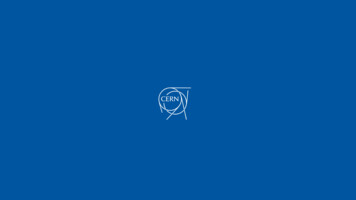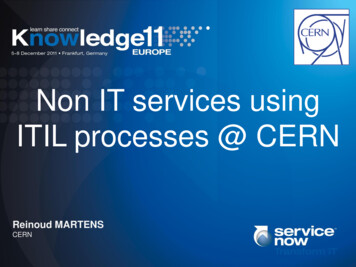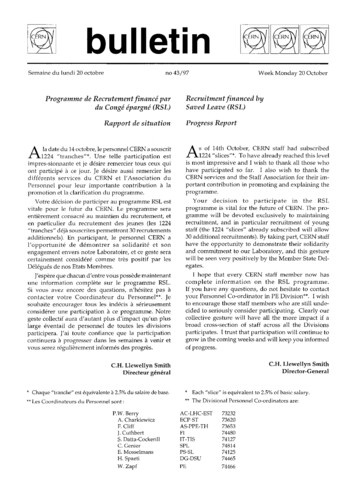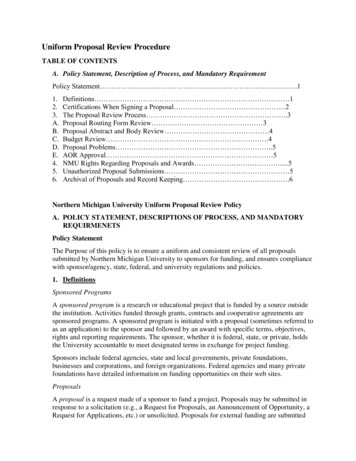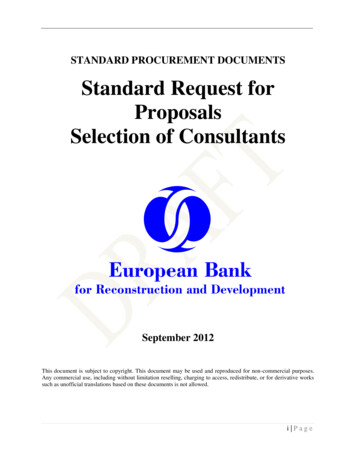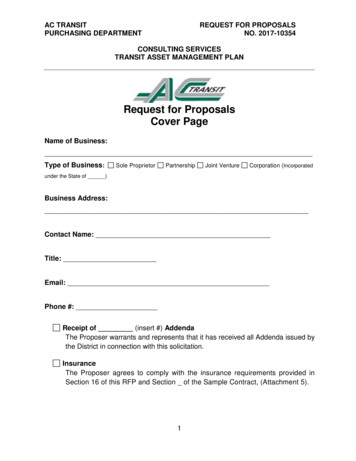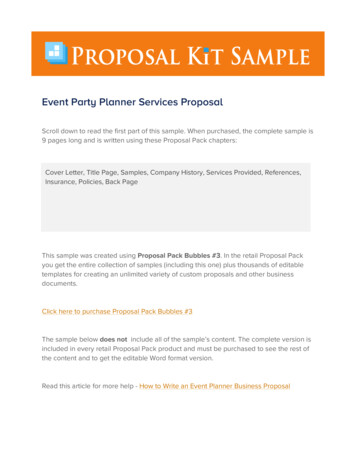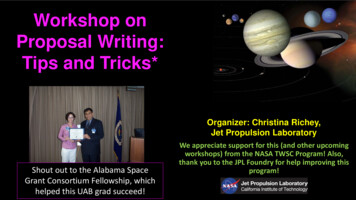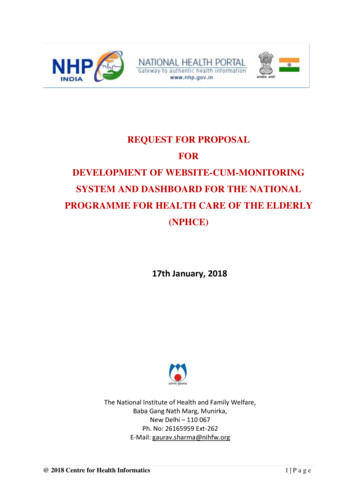
Transcription
I.I .,.c.,. . . ':) .CERN DD/OCTim Bemers- Lee, CER N /DDInformation Management: A ProposalMarch 1989Information Management: A ProposalAbstractThis proposal concerns the management of general information about accelerators and experiments atCERN. It discusses the problems of loss of infonnation about complex evolving systems and derives asolution based on a distributed hypertext sytstem.Keywords: Hypertext, Computer conferencing, Document retrieval, Information management, Project-control\'''IIIfor example\IIII--inf )------ "-. .;-./ ;describesincludes"""includes """""C.E.R.NIdescribes'1-./includest :: "-. .; ./ .IDD divisionrefersto\MISwrote\RA sectionTimBerners-LeeOC group
1'-"' ,. :h'v .f . .; btea. t-tno.;.,· . . );.r #g t."\ ,.; !vl'""'" "" "'.-· /.-1.-fS f.v(.tv.,fA.ue. If\.;.'"""V"o-.11i-11 .·t,.;-{ ;lk.)J.l rv ( .-t J
Information Management: A Proposalpage I1. Losing Information at CERNCER N is a wonderful organisation. It involves several thousand people, many of them very creative,all working toward common goals. Although they are nominally organised into a hierarchicalmanagement structure, this does not constrain the way people will communicate, and shareinformation, equipment and software across groups.The actual observed working structure of the organisation is a multiply connected NwebN whoseinterconnections evolve with time. In this environment, a new person arriving, or someone taking on anew task, is normally given a few hints as to who would be useful people to talk to. Information aboutwhat facilities exist and how to find out about them travels in the corridor gossip and occasionalnewsletters, and the details about what is required to be done spread in a similar way. i\11 thingsconsidered, the result is remarkably successful, despite occasional misunderstandings and duplicatedeffort.--)A problem, however, is the high turnover of people. When two years is a typical length of stay,information is constantly being lost. The introduction of the new people demands a fair amount oftheir time and that of others before they have any idea of what goes on. The technical details of pastprojects are sometimes lost forever, or only recovered after a detective investigation in an emergency.Often, the information has been recorded, it just cannot be found.If a CER N experiment were a static once-only development, all the information could be written in abig book. As it is, CERN is constantly changing as new ideas are produced, as new technologybecomes available, and in order to get around unforseen technical problems. When a change isnecessary, it normally affects only a small part of the organisation. i\ local reason arises for changing apart of the experiment or detector. At this point, one has to dig around to find out what other partsand people will be affectetl. Keeping a book up to date becomes impractical. and the structure of thebook needs to be constantly revised.The sort of infonnation \Ve arc discussing amwcrs, for example, questions like Where is this module usctl?Who wrote this code? Where does he work?What documents exist about that concept?Which laboratori s are included in that project?Which systems depend on this device?What documents refer to this one?The problems of information loss may be particularly accute at CERN, but in this case (as in certainothers), CERN is a model in miniature of the rest of world in a few years time. CERN meets nowsome problems which the rest of the world will have to face soon. In I 0 years, there may be manycommercial solutions to the problems above, while today we need something to allow us to continuc 1 The sameha. been true, for example, of electronic mail gateways, document preparation, and heterogeneous distruibutcdprogramming systems.
Information Management: A Proposalpage 22. Linked information systems.In providing a system for manipulating this sort of infonnation, the hope would be to allow a pool ofinformation to develop which could grow and evolve with the organisation and the projects it describes.ror this to be possible, the method of storage must not place its own restraints on the information.This is why a NwebN of notes with links (like references) between them is far more useful than a fixedhierarchical system. When describing a complex system, many people resort to diagrams with circlesand arrows. Circles and arrows leave one free to describe the interrelationships between things in a waythat tables, for example, do r:ot. The system we need is like a diagram of circles and arrows, wherecircles and arrows can stand for anything.We can call the circles nodes, and the arrows links. Suppse each node is like a small note, summaryarticle, or comment. I'm not over concerned here with whether it has text or graphics or both. Ideally,it represents or decribes one particular person or object. Examples of nodes can be PeopleSoft\.,·are modulesGroups of peopleProjectsConceptsDocumentsTypes of hardwareSpecific hardware objects" ' The arrows which links circle A to circle I3 can mean, for example, that A depends on Bis part of I3made nrefers to I3U!'es Dis an example ofnThese circles and arrows, nodes and links, 2 have di!Tcrent significance tn various sorts of conventionaldiagrams - v 1\-A.cL.J ""'" . " 1-: !" -lf',.'vd{.tl. t,'j-ttf--k.owJ."h.J." :-- Sf,.tf-C, !.·, t.,,.eA" ;,2N,{J.Js.,! if .li.l.: t}l,"") r» U.I}f-Linked information ystems have entities and rclation hips. There are, however, many differences between UCh a systemand an "Entity Relationship" database system. For one thing, the information stored in a linked system is largely commentfor human readers. For another, nodes do not have strict tyres which define exactly what relationships they may have.Nodes of similar type do not all have to be stored in the same place.
Infonnation i\hnagement: !\ Proposalpage JNodes are .Arrows mean .Family TreePeople"Is parent of"SASD diagramSoftware module"Passes data to"DependencychartSoftware modules"Depends on"People"Reports to"·organisationchartThe system must allow any sort of information to be entered. Another person must be able to find theinfonnation, sometimes without knowing what he is looking for.)In practice, it is useful for the system to be aware of the generic types of the links between items(dependences, for example), and the types of nodes (people, things, documents . ) without imposingany limitations.2.1 The problem with treesMany systems are organised hierarchically. The CERNDOC documentation system is an example, as isthe Unix file system, and the VMS/IIELP system. !\ tree has the practical advantage of giving everynode a unique name. However, it does not allow the system to model the real world. ror example, ina hierarchical IIELP system such as VMS/IIELP, one often gets to a leaf on a tree such asIIELP COMPILER SOURCE PORMAT PRi\GMJ\S DEFAULTSonly to find a reference to another leaf: WPieasc secIIELP COMPILER COi\lMAND LINE OPTfONS DEPAULTS PRJ\GMt\S.and it is necessary to leave the system and reccntcr it. What was neened was a link from one node toanother, because in this case the infomtation was not naturally organised into a tree.Another example of a tree-structured system is the uucp News system ('m' underhierarchical system of discussions ("newsgroupsl each containing articles contributedIt is a very useful method of pooling expertise, but suffers from the inflexibility of adiscussion under one newsgroup will develop into a different topic, at which point iidifferent part of the tree. (See Pigure I)2.2 The problem with keywordsUnix). This is aby many people.tree. Typically, aought to be in a'it Keywords arc a common method of accessing data for which one does not have the exact coordinates.The u ual problem with keywords, however, is that two people never cho e the same keywords. Thekeywords then become useful only to people who already know the application well.Practical keyword systems (such as that of Vt\X/NOTES for eltample) require keywords to beregistered. This is already a step in the right direction.
Information Management: !\ Proposalpage 4'·From duncan Thu Mar .Article 93 of alt.hypertext:Path: eppetto!duncan From: duncan@geppetto.ctt.bellcore.com (Scott Duncan)Newsgroups: alt.hypertextSubject: Re: Threat to free information networksMessage-ID: 14646@bellcore.bellcore.com Date: 10 Mar 89 21:00:44 GMTReferences: 1784.2416BB47@isishq.FIDONET.ORG 3437@uhccux.uhcc .Sender: news@bellcore.bellcore.comReply-To: duncan@ctt.bellcore.com (Scott Duncan)Organization: Computer Technology Transfer, BellcoreLines: 18Doug Thompson has written what I felt was a thoughtful article oncensorship -- my acceptance or rejection of its points is notparticularly germane to this posting, however.In reply Greg Lee has somewhat tersely objected.My question (and reason for this posting) is to ask where we mightlogically take this subject for more discussion. Somehow alt.hypertextdoes not seem to be the proper place.Would people feel it appropriate to move to alt.individualism or evenone of the soc groups. I am not so much concerned with the specificissue of censorship of rec.humor.funny, but the views presented inGreg' s article.Speaking only for myself, of course, I am .Scott P. Duncan (duncan@ctt.bellcore.com OR . !bellcore!ctt!duncan)(Bellcore, 444 Hoes Lane RRC lH-210, Piscataway, NJ . )(201-699-3910 (w)201-463-3683 (h))Figure 1:A note in the UUCP News scheme. The Subject field allows notes on the sametopic to be linked together within a '"newsgroup'". The name of the newsgroup(a:lt.hypertcxt) is a hierarchical name. This particular note is expresses a problemwith the strict tree structure of the scheme: this discussion is related to severalareas. Note the *References'", *rromN and NSuhject . fields can all be used togenerate links.A linked system takes this to the ne:ott logical step. Ke}'\vords can be nodes which stand for a concept.I\ keyword node is then no different from any other node. One can link documents, etc., to keywords.One can then find keywords by finding any node to which they are related. Jn this way, documents onsimilar topics are indirectly linked, through their key concepts. \J
Infonnation Management: A Proposalpage 5A keyword search then becomes a search starting from a small number of named nodes, and findingnodes which are close to all of them.It was for these reasons that I first made a small linked information system, not realising that a termhad already been coined for the technique: HIIypertextH.3. Personal Experience with HypertextIn 1980, I wrote a program for keeping track of software with \vhich I was involved in the PS controlsystem. Called Enquire, it allowed one to store snippets of information, and to link related piecestogether in any way. To find infonnation, one progressed via the links from one sheet to another,rather like in the old computer game "adventureH. I used this for my personal record of people andmodules. It was similar to the application llypcrcard produced more recently by Apple for theMacintosh. A difference was that Enquire, although lacking the fancy graphics, ran on a multiusersystem, and allowed many people to access the same data.Soon after my re-arrival at CER N in the DD division, I found that the environment was similar to thatin PS, and I missed Enquire. I therefore produced a version for the VMS, and have used it to keeptrack of projects, people, groups, e periments, software modules and hardware devices with which Ihave worked. I have found it personally very useful. I have made no effort to make it suitable forgeneral consumption, but have found that a few people have successfully used it to browse through theprojects and find out all sorts of things of their own accord.Meanwhile, several programs [ . ] have been made exploring these ideas, both commercially andacademically. Many of these have concentrated largely on the human interface aspects, and themethods of presenting linked infonnation to a person with a workstation. HHypertext" is a tenn coined in the 1950s by Ted Nelson [ . ], which has become popular for thesesystems, although it is used to embrace two different ideas. One idea (which is relevant to thisproblem) is the concept of information being linked together in an unconstrained way. The other idea,which is less immediately relevant and largely a question of technology and time, is of multimediadocuments, including graphics, speech and video. I will not discu:;s this latter aspect CHypcrmedia}futher here.It has been difficult to assess the effect of a large system on an organisation, often because thesesystems never had seriously large-scale use. Por this reason, we require large amounts of existinginformation should be accessible using any new information management system.
Information Management: A Proposalpage 6(concept)Documentation of the RPC projectMost of the documentation is available on \ IS, with the twoprinciple manuals being stored in the CERNDOC system.1)2)3)4)5)6)7)8)9)10)11)includes: The VAX/NOTES conference VXCERN: :RPCincludes: Test and Example suiteincludes: RPC BUG LISTSincludes: RPC System: Implementation GuideInformation for maintenance, parting, etc.includes: Suggested Development Strategy for RPC Applicationsincludes: "Notes on RPC", Draft 1, 20 feb 86includes: "Notes on Proposed RPC Development" 18 Feb 86includes: RPC User ManualHow to build and run a distributed system.includes: Draft Specifications and Implementation Notesincludes: The RPC HELP facilitydescribes: THE REMOTE PROCEDURE CALL PROJECT in DD/OCHelp Display Select Back Quit Mark Goto mark Link Add EditFigure 2: A screen in an Enquire scheme. This example is basically a list. so the list oflinks is more important than the text on the node itelf. Note that each link has atype ("includes" for example) and may al:;o have comment associated with it.(The bottom line is a menu bar.)4. RequirementsTo be a practical system in the CERN envimment, there arc a number of clear practical requirements.I.REMOTE ACCESS ACROSS NETWORKS.CER N is distributed, and access from remote machines is essential.2.HETEROGENEITYAccess to the same data from different types of system (VM/CMS, Macintosh, VAX/VMS,Unix).,
Information Management: A ProposalJ.page 7NON-CENTRAL/SAT/ONInformation systems start small and grow. They also start isolated and then merge. A newsystem must allow existing systems to be linked together without requiring any central controlor coordination.4.ACCESS TO EXISTING DATAIf we provide acess to existing databascs as though they were in hypertext form, the system willget ofT the ground quicker. This is discussed futher in an appendix.5.PRIVATE LINKSOne must be able to add one's own private links to and from public information. One mustalso be able to annotate links, as well as nodes, privately.6.BELLS AND WHISTLES. -.-------Storage of ASCII text, and di:;play on 24xRO screens, is quite sufficient, and essential. t\ditionof graphics would be an optional extra with very much less penetration for the moment.4.1 Client/Server ModelThe only way in which sufficient flexibility can be incorporated is to separate the information storagesoftware from the information display software, with a well defined interface between them. Given therequirement for network access, it is natural to let this clean interface coincide with the physicaldivision between the user and the remote database machine.This division also is important in order towould be a boon fot the \vorld in general.c; llowthe heterogeneity which ts required at CER N and(A client/server split at this level also makes multi-access more easy, in that a single server process canservice many clients, avoiding the problems of simultaneous access to one database by many differentusers.)l-J terI., s -Therefore, an important phase in the design of the system is to define this interf .; After that, thedevelopment of vari"ousof dispby .program-ancrof.dai.iifiase;c n-·pro.ccde in parallel. Thiswill have been done well if many different information sources, past, present and future, can be mappedonto the definition, and if many different human interface programs can be written over the years totake advantage of new technology and standards.(a·rm-sff, in the future, this work is repeated with the benefit of hindsight and experience (and internationalcooperation?), it may be done differently. However, one would imagine that the gateway techniquewould allow the new interface standard to be introduced painle:;sly.Important aspects of the standard interface are That it should be a superset of most existing and seriously concievable information systems; That advanced features should be mappable in a defined \Vay onto a simple subset of features; That it should be open to extension; ow
Information i\1anagement: t\ Proposalpage 8 That it should be open in that it does not impo e arbitrary constraints on any associated softwareapart from its own purpose. It should make no reference to particular properties of operatingsystems, etc. It should use existing standards whever possible for document and graphics representation, etc.4.2 Data analysisAn intruiging possibility, given a large hypcrtext database with typed links, is that it allows some degreeof automatic analysis. It is possible to search, for example, for anomalies such as undocumentedsoftware or divisions which contain no people. It is possible to generate lists of people or devices forother purposes, such as mailing lists of people to be infonned of changes.It is also possible to look at the topology of an organisation or a project, and draw conclusions abouthow it should be managed, and how it could evolve. This is particularly useful when the databasebecomes very large, and groups of projects, for example, so interwoven as to make it difficult to see thewood for the trees.In a complex place like CER N, it's not always obvious how to divide people into groups. Imaginemaking a large three-dimensional model, with people representaed by little spheres, and strings betweenpeople who have something in common at work. Now imagine picking up the structure and shakingit, until you make some sense of the tangle: perhaps, you see tightly knit groups in some places, and insome places weak areas of communication spanned by only a few people. Perhaps a linkedinformation system will allow us to see the real structure of the organistaion in which we work.4.3 Non requirementsDiscussions on I lypcrtcxt have sometimes tackled the problem of copyright enforcement and datasecurity. These are of secondary importance at CEH.N, where information exchange is still moreimportant than secrecy. Authorisation and accounting systems for hypertext could conceivably bedesigned which are very sophisticated, but they arc not proposed here.In cases where reference must be made to data which is in fact protected, existing file protectionsystems should be sufficient.5. SummaryThis proposal describes a universal linked information system, in which generality and portability arcmore important than fancy graphics techniques and complex extra facilities.IThe aim of the project would/he to allow a place to be found for putting any information or referencewhich one felt \vas importantl and a way. of finding it aftwerwards. The result should be sufficientlyattractive to use that it the i formation contained would grow past a critical threshold, so that theusefulness the scheme would in turn encourage its increased use.iIII!
page 9Information Management: 1\ ProposalThe passing of this threshold accelerated by allowing large existing databases to be linked together andwith new ones.,J1. SJk .,.-!."{ . j- -t t. .!. ?pL. .,.fa,. of1 (h' b . I. .' r.-4 c,.·.p-. .·J.v.c1 d-,voNrfl.-.- C- itNS ,. - -----··- --·---------.f1 - ?k--. 'l J. ,j.{ bwt.'s:t .rl l\ .e:t.;: ------ - . - c-e t2.w.:tSr).'! C: t.· 1-J; rt.I.: t. h'H.,(-/.u. .J.t. . .' (.I l.k. h' / I I; J.n .1.1;- - ----- -·-·- --·-· . -·-- -:.A,11 :'W:. ., .-A.rt A-"1:- . " "''. - ---- . rvlt "'-l-----. ",.b IV\.JS 'tw .L 4--rt.·l'-t, # 4--vJ\.v. M------------·-------------. --------,. ------·--··- . ·--··----···-···-·· -·.")'h.sr)J . .,-------·"(1 t '-4lJ. c. t. - .'';V. kP.\, g, ,s . IA-!.u hIse( ., J{i
Information Management: i\ Proposalpage 10Appendix AAccessing Existing DataThe system must achieve a critical usefulness early on. Existing hypcrtext systems have had to justifythemselves solely on new data. lf, however, there was an existing base of data of personel, for example,to which new data could be linked, the value of each new piece of data would be greater.What is required is a gateway program which will map an existing structure onto the hypertext model,and allow limited (perhaps read-only) access to it. This takes the form of a hypertext server written toprovide existing information in a fonn matching the standard interface. One would not imagine theserver actually generating a hypertext database from and .existing one: rather, it would generate ahyperytext view of an existing database.,., . :Om. t.t .,.Some examples areI.UUCP NEWSThis is a Unix electronic conferencing system. i\ server for uucp news could makes linksbetween notes on the same subject, as well as showing the structure of the conferences.2.VAX/NOTESThis is Digital's electronic conferencing system. It has a fairly wide following in f ermiLab, butmuch less in CERN. The topology of a conference is quite restricting.3.CERNDOCThis is a document registration and distribution sy tcm running on CERN's VM machine. t\swell as documents, categories and projects, keywords and authors lend themselves torepresentation as hyperte;'{t nodes.4.FILE SYSTEMSThis would allow any file to be linked to from other hypertext documents.5.TilE TELEPHONE BOOKEven this could even be viewed as hypertext, with links between people and sections, sectionsand groups, people and floors of buildings, etc.6.T!IE UNIX MANUALTI1is is a large body of computer- readable text, currently organised in a flat way, but whichalso contains link information in a standard format rsee also . ).ln some cases, writing these servers would mean unscrambling or obtaining details of the e:mtmgprotocols and/or file formats. It may not be practical to provide the full functionality of the originalsystem through hypert :xt. In general, it will be more important to allow read access to the generalpublic: it may he that there is a limited number of people who are providing the information, and thatthey are content to use the existing facilities.J.:
Information Management: A Proposalpage 11It is sometimes possible to enhance an existing storage system hy coding hypertext information in, ifone knows that a server will be generating a hypertext representation. In 'news' articles, for example,one could use (in the text) a standard format for a reference to another article. This would be pickedout by the hypertext gateway and used to generate a link to that note. This sort of enhancement willallow greater integration between old and new systems.N; K.There will always be a large number of information management systems - we get a lot of addedusefulness from being able to cross-link them. Howver, we will lose out if we try to constrain them, aswe will exclude systems and hamper the evolution of hypertext in generaL,}/C)c .voVI-"\.Sd. c.HG::.r sJ "' 1.t.o t.t \!\--.C- . ro .\d '--r-S-:-. . h-)/rJ -0······/ .(.a')(." ,,
Information Management: A Proposalpage 12Appendix BSpecific ApplicationsThe following are three examples of specific places in which the proposed system would be immediatelyuseful. PROJECT DOCUMENTATION.The Remote procedure Call project has a skeleton description using Enquire. /\!though limited, itis very useful for recording who did what, where they are, what documents exist, etc. i\lso, onecan keep track of users, and can easily append any extra little bits of information which come tohand and have nowhere else to be put. Cross-links to other projects, and to databases whichcontain information on people and documents \Vould be very useful, and save duplication ofinformation. DOCUMENT RETRIEVALThe CERNDOC system provides the mechanics of storing and printing documents. i\ linkedsystem would allow one to browse through concepts, documents, sytcms and authors, alsoallowing references between documents to be stored. (Once a document had been found, theexisting machinery could be invoked to print it or display it). TilE nr'ERSONAL SKILLS !NVENTORYH.Personal skills and experience are just the sort of thing which need hypertcxt Ocxibility. Peoplecan be linked to projects they have worked on, which in turn can be linked to particularmachines, programming languages, etc.
Information i'vfanagement: t\ Proposalpage IJAppendix CProject ingredients: old and newMany parts of the proposed system should be available from existing sources. t\ search of relatedsoftware may well extend this list. In some cases (marked * below) the technology is new, andalthough it is servicable it may have to be replaced when something better comes along. In others,acceptable standards or software probably exists (marked """)The work required is broken into parts as discussed above: the interface specification, and initial pilotclient and server programs.C.l Interface specificationI.2.J.RHFHRENCE LOGICAL DATA MOD !, DESIGN*a.Single/bidirectional links. There arc advantages if a link in one direction automaticallyis accessible in the other direction. This orten doubled the usefulness of the originallink. I Iowever, it causes problems if the make of the link only has write access to oneof the things he is linking.b.Private and public links. It is necessary to be able to make one's own private linksbetween public objects. These links may be stored locally on one's own machine, forefficiency and privacy. Their implemenattion must be made consistent with publiclinks stoed in the servers.·c.Overlaying of equivalent nodes in different databascs. /\s datahascs growm it oftencomes about that the same thing crops up in both. After a certain time, this becomesaparent, and the two should be merged. I [owever, it is still useful (for efficiency, andprotection reasons) to keep entried in both databascs. Therefore, one requires a ·virtualmerging" of nodes, so that the information about the same thing is displayed together,subject to a particular client's rights and ability to access the various schemes.Choice of document representation formatsa.Format negotiation, coersion to lowest common format. A basic comrnom standardmust exist which can be displayed on a 24x80 character screen using ASCII characters.All servers must be prepared to produce data in that format. Other formats may beincluded, such as marked up text and graphics, subject to agreement between the clientand server. In this way, new formats can he introduced as they become available.b.Reference to existing standardsUNK DEFINITION FOR;\411Ta.Network address of server b.Node reference within serverc.Link identification within node*"'
lnfonnation Management: 1\ Proposald.4.5.page 14Logical naming for network independenceCOMMUNICATlON STANDARDSa.Heterogeneous RPCb.Network naming standards Human Interface Window systems*** etc.C.2 Template clientI.Human Interface tools (X- windows etc)2.Text/Graphics editors****/""3.Stashing techniques\*C.3 Template server!.Database technology**CA Template server gatewayl.Require access to existing protocols Referencesl.Nelson, T.JI. *Getting it out of our system* in lnformalion Retrieval: A Critical ReviewN. G.Schechter, ed. Thomson nooks, Washington D.C., 1967, 191·2102.Smish, J.ll and Weiss, S.P,*i\n Overview of llypertextN, in Communications oftlzc1988 Vol 31, No. 7, and other articles in the same special N!lypertext* issue.3.Campbell, n and Goodman, J, HAM: a general purpo e I lypcrtext Abstract i\lachine*, inCommunications of tlze ACM July 1988 Vol 31, No. 74.1\kscyn, R.M, McCracken, D and Yoder E./\, HKMS: 1\ distributed hypermedia system formanaging knowledge in organisaions·, in Communications oftlze ACM July 1988 Vol31, No. 7- Hypertext on Hypertext- existing systems - rn, NOTES, etc, CERNDOCAC/ lJuly
This proposal concerns the management of general information about accelerators and experiments at CERN. It discusses the problems of loss of infonnation about complex evolving systems and derives a solution based on a distributed hypertext sytstem. Keywords: Hypertext, Computer conferencing, Document retrieval, Information management, Project
